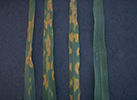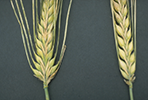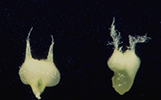International Database for Barley Genes and Barley Genetic Stocks








The demand for an International Database for Barley Genes and Barley Genetic Stocks began already in the 1980s. Compiling data started in 1971 in Barley Genetics Newsletters first issue, but took an intensely new turn during the 1990s.
This constructed database you find here comprises two parts. The main part shows an overall structure of the descriptions with special paragraphs dedicated to cover previous nomenclature, inheritance, locus location, descriptions of morphological and physiological characters, the first detected mutant, mutant events, mutants used for description, parent germplasm and references. It includes for the locus name the use of the three-letter symbols. The chromosome numbers and arms designations are based on the Triticeae system. Both systems were approved at the business meeting of the Seventh International Barley Genetics Symposium on 5th August 1996. Each mutant is associated with a stock number, this barley genetic stock (BGS) number corresponds to an accession (GSHO or NGB) number kept in the Barley Genetic Stock Collection, Aberdeen, Idaho, USA, or at NordGen, Alnarp, Sweden. Only one allele of each description is kept at the Main Stock Center in Aberdeen but all alleles are stored at NordGen.
During many years hundreds of genetic stocks containing morphological and physiological characters were brought together world-wide from different regions and different backgrounds. By the tremendous and skillful crossing work of J.D. Franckowiak, USA, it was possible to transfer about 1000 of these genes into a common genetic background, the two-rowed cultivar ‘Bowman’. These lines are also included in this database. The BGS database now comprises about 700 hundred descriptions with more than 4000 alleles and about 2000 references. Many of the genes are illustrated with images, both overviews and close-up character photographs. Most of them are taken in Bowman backcrossed derived lines and compared with the normal cultivar.
The second part of the database comprises basic information of about all 10000 Swedish barley mutants to find their original stock accession for degeneration, mutagens used for induction, inheritance and their relation to BGS descriptions. The database is easy to be used, by names, symbols and other objects you are looking for. (Many of the germplasm accessions are hyperlinked to Web pages of the holding gene banks in order to facilitate easy ordering of material.)
How to cite:
Hansson, M., Youssef, H.M., Zakhrabekova, S. et al. A guide to barley mutants. Hereditas 161, 11 (2024). https://doi.org/10.1186/s41065-023-00304-w
